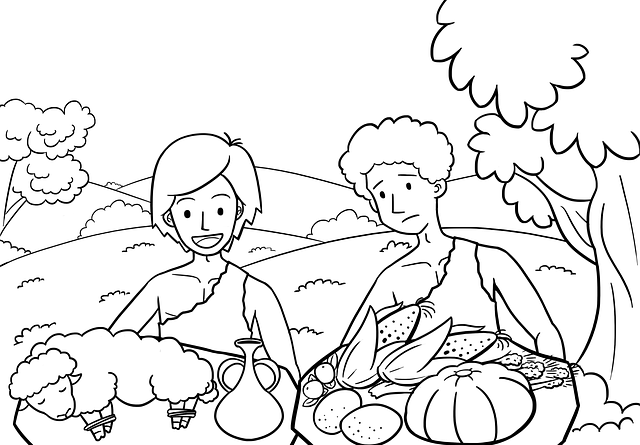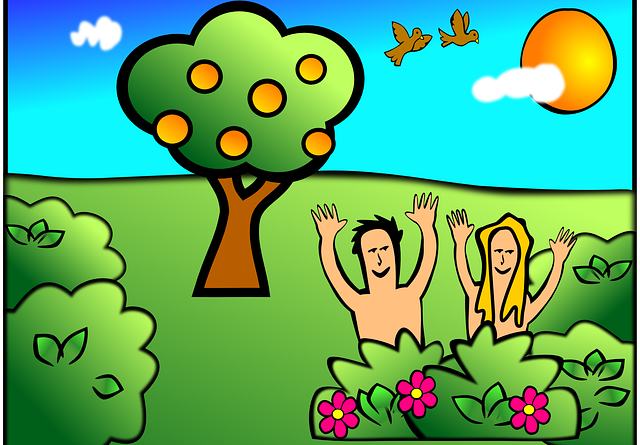Once upon a time, on the sixth day of creation, God formed a man named Adam. He breathed life into Adam, and placed him in a beautiful garden called Eden. In this garden, there were magnificent trees and fruits to enjoy. God instructed Adam to tend to and watch over the garden, but there was one tree that he was not allowed to eat from – the Tree of the Knowledge of Good and Evil. Feeling lonely, God decided to create a helper for Adam. He brought all the animals to Adam to be named, but none were the right fit. So, God made a woman named Eve from one of Adam’s ribs, and the two became husband and wife. They lived in the garden, both naked and without shame, until one day when a serpent tempted Eve to eat from the forbidden tree. She shared the fruit with Adam, and their eyes were opened to their own nakedness. They felt ashamed and covered themselves with fig leaves. When God discovered what they had done, he punished the serpent, cursed the ground, and banished Adam and Eve from the Garden of Eden.
Creation of Man and Garden of Eden
Formation of Man from dust
On the sixth day of creation, God formed Man from the dust of the earth. He breathed the breath of life into his nostrils, and the man became a living person. This incredible act demonstrated God’s power and creativity in bringing humans into existence.
God plants a garden in Eden
After forming man, God planted a garden in Eden and placed the man there. The purpose of this garden was to provide a beautiful and abundant environment for the man to dwell in. God ordered beautiful trees and trees that bear fruit to grow up from the ground in the middle of the garden. The creation of this garden highlights God’s desire for humanity to live in a place of abundance and provision.
Instructions for the man
In the garden, God gave the man specific instructions. He told him that he could freely eat the fruit of every tree in the garden, except for the tree of the knowledge of good and evil. God warned the man that if he were to eat from this particular tree, he would surely die. This instruction emphasized the importance of obedience and the consequence of disobedience.
Creation of the Tree of Life
Among the trees in the garden, God placed the Tree of Life. This tree possessed the extraordinary ability to grant eternal life. Its presence symbolized God’s intention for humanity to have a continuous and everlasting relationship with Him. However, this tree also represented the importance of obedience and the consequences of making wrong choices.
Creation of Woman
God’s decision to make a helper for man
God recognized that it was not good for man to be alone, so He made a decision to create a suitable helper for him. This decision revealed God’s understanding of human needs and His desire for companionship and unity.
Naming of the animals
God brought all the animals to the man to be named by him. This act showcased the man’s authority and responsibility over God’s creation. However, even after naming all the animals, the man still did not find a suitable helper among them. This event further established the need for a distinct companion for the man.
Formation of woman from man’s rib
To create the woman, God caused the man to fall into a deep sleep. During this sleep, God took one of the man’s ribs and closed up the opening. From the rib, God made a woman and brought her to the man. The man, upon seeing the woman, exclaimed, “This one is bone from my bone and flesh from my flesh.” This act of creating woman from man’s rib emphasized the unity and interconnectedness between man and woman.
Marriage and Unity
The man’s exclamation about woman
Upon seeing the woman, the man acknowledged the deep connection between them. He proclaimed, “This one is bone from my bone and flesh from my flesh.” This exclamation expressed the sense of unity and oneness that exists within the institution of marriage.
Explanation of marriage and unity
God explained that a man leaves his father and mother and joins to his wife, and the two become united into one. This explanation emphasized the significance of marriage and the profound bond that is formed between husband and wife. It highlighted the importance of unity and partnership in the relationship between man and woman.
Temptation and Disobedience
Introduction of the serpent
One day, the serpent, the most clever of all the wild animals, approached the woman and questioned her about what God had commanded them regarding eating fruit from the trees in the garden. The introduction of the serpent marked the beginning of temptation and the testing of mankind’s obedience to God’s instructions.
Conversation between the serpent and the woman
The serpent deceived the woman by contradicting God’s command and assuring her that she would not die if she were to eat the fruit from the tree in the middle of the garden. He enticed her with the promise that her eyes would be opened, and she would become like God, knowing good and evil. This conversation showcased the cunning nature of the serpent and the vulnerability of the woman to his deceitful words.
The woman’s decision to eat the forbidden fruit
After being convinced by the serpent’s words, the woman made the decision to eat the forbidden fruit. She disregarded God’s command and succumbed to temptation. This act of disobedience symbolized the introduction of sin into the world and the breaking of the harmonious relationship between humans and God.
Eating of the fruit
The woman, having eaten the forbidden fruit, shared it with her husband. Both of them partook in this act of disobedience, thus bringing the consequences of sin upon themselves and all of humanity. They chose to prioritize their own desires over their obedience to God.
Realization of their nakedness and the sewing of fig leaves
Immediately after eating the fruit, the man and the woman’s eyes were opened, and they realized their nakedness. They felt ashamed and sought to cover themselves by sewing fig leaves together. This realization showcased the immediate consequences of their disobedience and the introduction of shame and guilt into their lives.
God’s Presence in the Garden
God walking in the garden
In the cool of the evening, Adam and Eve heard God walking in the garden. The presence of God in the garden signified His desire for a relationship with His creation. It highlighted His closeness and accessibility to humanity.
God’s call to the man
Upon hearing God’s presence, God called out to the man, “Where are you?” This call demonstrated God’s pursuit of humanity even after the fall. It showcased His love and desire to restore the broken relationship between Himself and mankind.
Discovery of their nakedness
When God called out to the man, the man revealed that he hid from God because he was naked. This discovery further emphasized the realization and shame that came with their disobedience and the consequences of their actions.
Confrontation with God about eating the forbidden fruit
God questioned the man about his disobedience, and the man immediately shifted blame to the woman. When God questioned the woman, she blamed the serpent. This confrontation illustrated the unwillingness of both the man and the woman to take responsibility for their own actions. It showcased the brokenness and discord that entered the world as a result of sin.
Consequences for Serpent, Woman, and Man
Curse upon the serpent
God cursed the serpent as a result of its deceit and manipulation. He stated that the serpent would crawl on its belly and that there would be enmity and division between it and the woman. God also prophesied that the woman’s offspring would crush the serpent’s head while the serpent would bruise the offspring’s heel. This curse highlighted the eternal conflict between good and evil and the ultimate victory that would come through the offspring of the woman.
Pain of childbirth for the woman
As a consequence of the woman’s disobedience, God pronounced that the pain of childbirth would be greatly increased. This consequence highlighted the physical and emotional struggles that women would experience as a result of sin.
Man’s rule over the woman
God stated that the woman’s desire would be for her husband, and he would rule over her. This consequence represented a shift in the relationship dynamics between man and woman. It indicated the potential for abuse of power and the introduction of inequality into the marital relationship.
Curse upon the ground and hard work for the man
As a result of the man’s disobedience, God cursed the ground and declared that it would produce thorns and thistles. He also proclaimed that the man would have to toil and work hard to grow his own food until he returned to dust. This curse highlighted the hardships and challenges that would come with laboring for sustenance in a fallen world.
Naming of Eve and Banishment from Eden
Adam naming his wife Eve
After God pronounced the consequences for their actions, Adam named his wife Eve. This act represented Adam’s recognition of their partnership and the importance of their relationship in the face of the difficulties that lay ahead.
God providing clothing from animal skins
To cover the nakedness of Adam and Eve, God provided clothing made from animal skins. This act emphasized God’s care and provision even in the midst of their disobedience and the consequences they faced.
Banishment from the Garden of Eden
Finally, God banished Adam and Eve from the Garden of Eden, indicating that access to the tree of life was no longer possible. This banishment symbolized the severing of the close relationship between humanity and God that existed before their disobedience. From that point on, mankind would have to labor and strive outside of the perfect garden environment.








